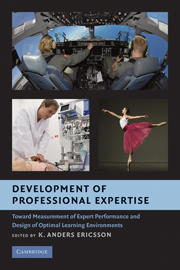 Development of Professional Expertise
Development of Professional Expertise Book contents
- Frontmatter
- Contents
- List of Figures
- List of Tables
- List of Contributors
- 1 The Measurement and Development of Professional Performance: An Introduction to the Topic and a Background to the Design and Origin of This Book
- SECTION 1 CHALLENGES IN PAST AND CONTEMPORARY EFFORTS TO MEASURE AND TRAIN THE OBJECTIVE PERFORMANCE OF PROFESSIONALS
- SECTION 2 PAST AND CONTEMPORARY EFFORTS TO DESIGN INSTRUCTION, TRAIN, AND MAINTAIN PROFESSIONAL PERFORMANCE
- SECTION 3 THE ASSESSMENT AND TRAINING OF SKILLED AND EXPERT PERFORMERS IN THE MILITARY
- 10 Toward a Second Training Revolution: Promise and Pitfalls of Digital Experiential Learning
- 11 Evaluating Pilot Performance
- 12 Contrasting Submarine Specialty Training: Sonar and Fire Control
- 13 Training Complex Cognitive Skills: A Theme-Based Approach to the Development of Battlefield Skills
- 14 Structuring the Conditions of Training to Achieve Elite Performance: Reflections on Elite Training Programs and Related Themes in Chapters 10–13
- SECTION 4 THE DEVELOPMENT OF EXPERTISE AND EXPERT PERFORMANCE
- Name Index
- Subject Index
- References
12 - Contrasting Submarine Specialty Training: Sonar and Fire Control
Published online by Cambridge University Press: 04 August 2010
- Frontmatter
- Contents
- List of Figures
- List of Tables
- List of Contributors
- 1 The Measurement and Development of Professional Performance: An Introduction to the Topic and a Background to the Design and Origin of This Book
- SECTION 1 CHALLENGES IN PAST AND CONTEMPORARY EFFORTS TO MEASURE AND TRAIN THE OBJECTIVE PERFORMANCE OF PROFESSIONALS
- SECTION 2 PAST AND CONTEMPORARY EFFORTS TO DESIGN INSTRUCTION, TRAIN, AND MAINTAIN PROFESSIONAL PERFORMANCE
- SECTION 3 THE ASSESSMENT AND TRAINING OF SKILLED AND EXPERT PERFORMERS IN THE MILITARY
- 10 Toward a Second Training Revolution: Promise and Pitfalls of Digital Experiential Learning
- 11 Evaluating Pilot Performance
- 12 Contrasting Submarine Specialty Training: Sonar and Fire Control
- 13 Training Complex Cognitive Skills: A Theme-Based Approach to the Development of Battlefield Skills
- 14 Structuring the Conditions of Training to Achieve Elite Performance: Reflections on Elite Training Programs and Related Themes in Chapters 10–13
- SECTION 4 THE DEVELOPMENT OF EXPERTISE AND EXPERT PERFORMANCE
- Name Index
- Subject Index
- References
Summary
Within the submarine environment, sonar technicians (ST) and fire control technicians (FT) are the two largest groups of enlisted submarine specialists. The specialties, and therefore the training and performance metrics, differ in interesting ways. Sonar is largely a perceptual discrimination skill while fire control is more of a cognitive skill. The primary task of an ST is to detect and classify the signal (i.e., a sound wave) of a sonar contact; the FT's primary task is to localize (determine course, speed, and range) the sonar contact, using a set of tools, procedures, and algorithms. For both these submarine specialties, the training pipeline is changing with the addition of periodic, just-in-time, ashore classroom sessions interspersed with at-sea shipboard practice. Other significant changes include the development of more objective performance measurements that supplement the traditional qualification metrics. As a result, the STs and FTs of tomorrow should have far more systematic and comprehensive training and evaluation than even today's senior enlisted specialists.
The decision makers in the submarine environment, as everywhere, depend on sensory information that allows them to understand the state of the world. In many domains, much of that sensory information is readily available right before the eyes of the decision maker – the chess player can see the playing board and the golfer can see how the ball lies relative to the course. In contrast, there is no directly observable information about the non-static situation outside the submarine.
- Type
- Chapter
- Information
- Development of Professional ExpertiseToward Measurement of Expert Performance and Design of Optimal Learning Environments, pp. 271 - 285Publisher: Cambridge University PressPrint publication year: 2009
References
- 3
- Cited by


